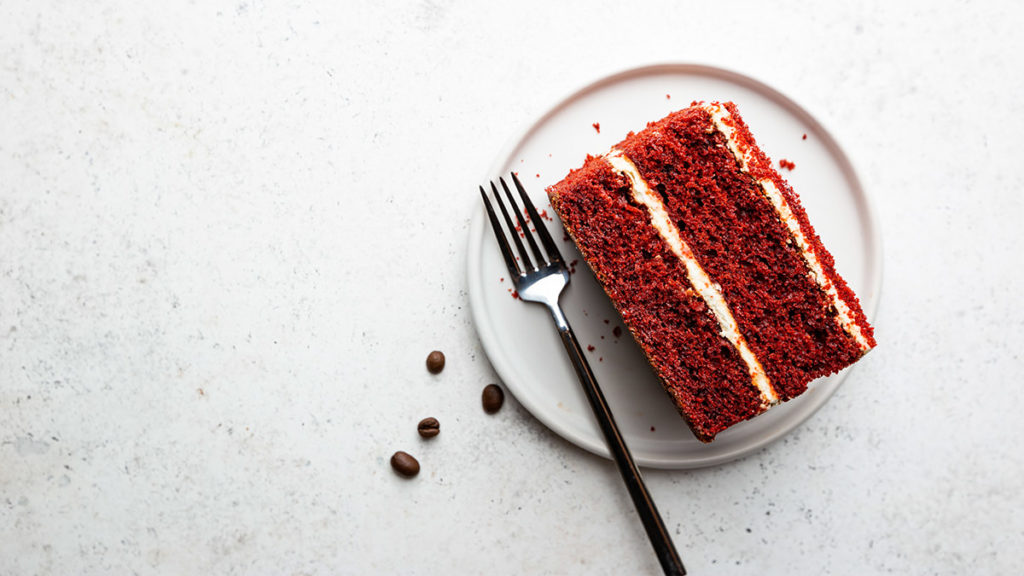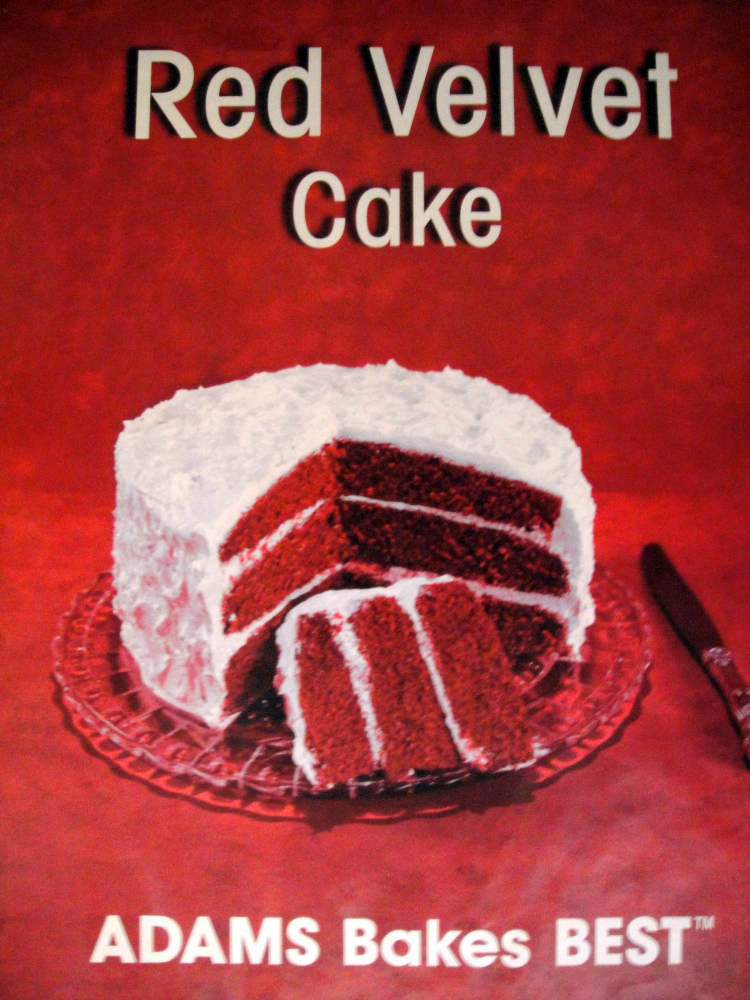Popular in the southern U.S., red velvet cake is a vanilla cake with a few tablespoons of cocoa powder and red food coloring mixed in. Vinegar and buttermilk bring some acid to the batter, adding a bit of tanginess that balances out the sweet cream cheese-butter frosting that is standard.

The birth of a flavor classic
The earliest velvet cakes date back to Victorian times, when bakers in both the United States and England began to use cocoa powder to produce cake of a fine, crumbed texture, one that was much softer than the traditional yellow or white varieties. As the 1900s dawned in America, velvet-style cakes, including mahogany cake and devil’s food cake, became increasingly popular. A blend of the two, called velvet cocoa cake — the most direct relative of our modern red velvet — emerged in 1911.
As bakers continued to increase the amount of unprocessed cocoa in their mixes, they began to inject a brownish-red hue in their final products. This inspired variations of velvet cocoa known as red regal and red feather cake, the recipes for which first appeared in Midwest newspapers during the 1920s.

The reason cocoa causes reddening, and the extent to which it does, remains under debate in the culinary community. Some, such as Bobbie Lloyd, chief baking officer at New York’s legendary Magnolia Bakery, assign this early red tint to a reaction occurring when cocoa powder and buttermilk — both acidic substances — are combined with baking soda. Other bakers, and even some chemists, downplay cocoa’s role, insisting the inclusion of brown sugar (originally called red sugar) in the velvet cocoa cake recipe is what caused the original tint.
Regardless of the source of its color, the version of red in the velvet cocoa cake is nowhere near as vibrant our modern cake’s rich crimson color — which, surprisingly, plays no large role in its flavor.
By the early 1940s, the dark red of velvet cakes had intensified even more. This was rumored to be the result of the addition of beet juice — a popular ingredient in baked goods at the time, due to government food rationing during World War II — to existing velvet recipes. The reddening can also be ascribed to the type of cocoa used in batters of the era. Dutch-processed cocoa, a refined, less bitter version of natural cocoa, became scarce during rationing, leading cooks to utilize other cocoa blends that reddened when mixed with buttermilk.
Recipe tinkering continued, until, in 1943, Irma Rombauer’s classic cookbook The Joy of Cooking introduced America to a dish called red velvet cake. Still, this wasn’t the red velvet we know — some claim that version was under development almost 20 years earlier, in New York City.

Manhattan’s Waldorf Astoria, a hotel whose storied kitchen also invented the brunch classic eggs Benedict and namesake Waldorf salad, served one of the earliest “modern” red velvet cakes, if not the first. While the hotel long claims to having served its first version in the mid-1920s, culinary journals including Southern Living report the red velvet cake first appeared at the Waldorf in the mid-1930s — around the same time ritzy Toronto department store Eaton’s starting serving red velvet cake. Eaton’s billed its cake as the creation of socialite Lady Flora Eaton, the wife of wealthy retail heir and royally appointed Canadian knight Sir John Craig Eaton (a claim Southern bakers contest to this day).
In 1940, Texas-based food coloring and extract salesman John A. Adams and his wife, Betty, spent a weekend at the Waldorf, during which they sampled the hotel’s trademark red velvet. That experience inspired the couple to develop their own red velvet cake as a marketing tactic for the Adams Extract brand. In their version, they added a significant amount of their red food coloring, and also replaced butter, which the government was rationing at the time, with butter flavoring and vanilla extract.
Plan in place, the couple packaged these two ingredients with a recipe card and red food coloring, and successfully sold their red velvet cake kit in major grocery stores across the country.
Food History: Red Velvet Cake
FAQ
How is red velvet cake traditionally made?
Is red velvet just chocolate dyed red?
Was red velvet cake originally made with beets?
What is the red velvet flavor made of?
What is a red velvet cake?
To understand the traditional red velvet cake, you must go back in time. Velvet cakes first came into existence during the Victorian Era. It was during the 1800’s that recipes would frequently call for the use of cocoa for luxury cakes. They would call the cakes “velvet” cakes and serve them at fancy dessert parties.
When was red velvet cake invented?
According to Serious Eats editor emeritus Stella Parks, during her appearance on The Splendid Table, a combination of devil’s food cake and the mahogany cake was first published in 1911 as a recipe for a velvet cocoa cake. So, Is Red Velvet Cake Southern?
What makes a good red velvet cake?
A quality red velvet cake is smooth and, you guessed it, velvety in nature. The texture of the cake was influenced by the ingredients that were used to make these types of cakes. While some recipes for red velvet cake have varied throughout the years, they all had some combination of baking soda and either buttermilk or vinegar.
Why is red velvet called Red Velvet?
It’s funny that the “red” portion of “red velvet” became the aesthetic focus that we consider. This is because the velvet name was actually in reference to the texture. A quality red velvet cake is smooth and, you guessed it, velvety in nature. The texture of the cake was influenced by the ingredients that were used to make these types of cakes.
